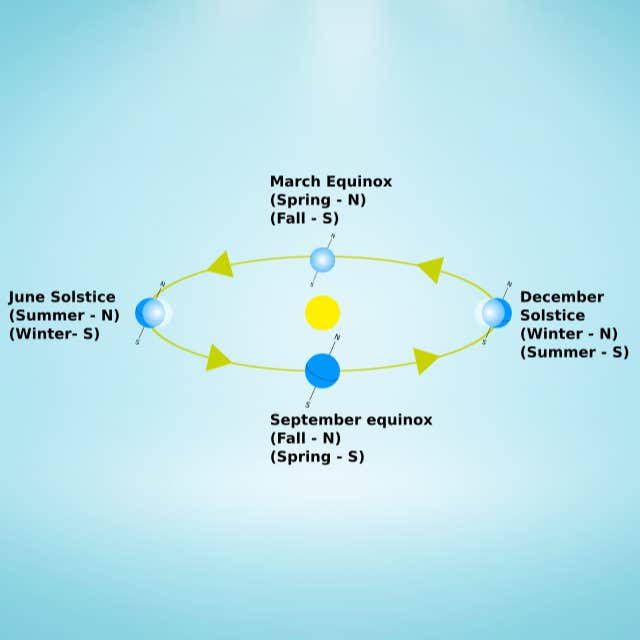The Difference Between The Equinox And The Solstice
It's not just about the changing seasons.
 pixelshot, Soeren Lubitz/ Getty Images via Canva
pixelshot, Soeren Lubitz/ Getty Images via Canva Although that first little chill in the air or that whiff of pumpkin spice may get your fall and winter sensors on high alert as much as seeing flowers bloom, the sun coming back out, and seeing color again in the spring and summer, these things are not what signifies the start of a new season.
The true official start of a season is indicated by a solstice or an equinox.
Depending on where you are in the world though, the start of a new solstice or equinox can be different, therefore it might be possible for one solstice to be on the same day as a new equinox based on the northern hemisphere and southern hemisphere.
It's also hard to say an exact date when each equinox or solstice will happen as a calendar year has 365 days but it takes 365.25 days for the Earth to travel around the sun, making it unequal. That's why we have a leap year every four years to make up for this inconsistency.
While solstice and equinox both have to do with the changing of seasons, they are very different from each other. But before you can understand the difference between an equinox and a solstice, it's essential to know more about each event.
What is a solstice?
According to the Oxford Dictionary, a solstice is "the time or date (which happens two times of the year) at which the sun reaches its maximum or minimum declination, marked by the longest and shortest days."
The winter solstice is always the longest night of the year and, consequently, the summer solstice is the longest day of the year. This is due to the fact that a solstice is characterized by days that have the least or the most daylight in a year.
The most northern and southern places on earth will experience even longer nights and days during a solstice. This occurs because the sun actually comes to a stop before it reverses its direction.
A solstice can only happen when the path of the sun is at the absolute farthest distance from the equator. "Solstice" is actually a Latin word that combines "sol," meaning Sun, and "sistere," meaning to stand still.
However, you didn't need to take Latin in high school to understand the meaning of a solstice. All you really need to know is that a solstice signals the beginning of the summer and winter seasons, hence why the longest day will always take place in the Summer and the longest night in the Winter.
What is an equinox?
According to the Oxford Dictionary, an equinox is "the time or date (twice each year) at which the sun crosses the celestial equator, when day and night are of approximately equal length."
The equinox is all about equality. When an equinox occurs, a day will have equal amounts of daylight and darkness.
During an equinox, the sun will spend the same amount of time both below and above the horizon and the tilt of the earth. The sunlight and darkness equal out to 12 hours each throughout an equinox.
"Equinox" is also aptly derived from Latin. The term comes from the words "aequus," meaning equal, and "nox," meaning night. There are two equinoxes: the autumnal equinox, also known as the fall equinox, and the vernal equinox, also known as the spring equinox.
An equinox covers the start of the other two seasons, spring and fall.
What is the difference between an equinox and a solstice?
1. The sun's position
A big difference that separates an equinox from a solstice is that an equinox occurs only when the sun is closest to the equator. The equator will pass through the center of the sun's disc when this event happens.
2. The effect on the day
Equinoxes don't alter the length of day and night as solstices do. Solstices can make a day or a night longer than they originally are. Equinoxes occur on days that have an equal number of hours for day and night.
3. Position of the earth
The earth is farthest away from the sun during the two solstices. The earth is closest to the sun during the equinoxes. Thus, there are different temperatures and seasons in regard to solstices or equinoxes.
4. The seasons are different
The solstice marks the start of Summer and Winter. Equinoxes mark the beginning of Fall and Spring. So, you can tell if it's an equinox or solstice depending on what season you are in.
It's important to mark solstices and equinoxes because we now use them to mark the change of the seasons. However, back in the day, they used the sun to mark daily and annual time because solstices and equinoxes were important to mark for agriculture, as each season's solstice or equinox represents and signifies a meaning in different cultures.
Solstice & Equinox Dates
 Photo: Colivine, CC0, via Wikimedia Commons
Photo: Colivine, CC0, via Wikimedia Commons
Spring Equinox (March 19, 20, or 21)
Before the spring equinox, the earth is closest to the sun, otherwise known as at perihelion, about two weeks after the December solstice.
Then at the start of the spring equinox, also known as the vernal equinox, the sun crosses the equator line and heads north, marking it the start of spring and resulting in increased daylight hours and warmer temperatures.
In general, the spring equinox signifies birth, renewal, growth, and the start of the planting season.
One interesting fact about the spring and fall equinoxes is that you can supposedly stand an egg on its end during the equinox. The myth comes from ancient Chinese stories, who created displays of eggs standing on end on the first day of spring. During the spring, many festivals are celebrated like Easter and Passover.
Summer Solstice (June 20 or 21)
Otherwise known as the longest day of the year, the summer solstice varies between June 20 and June 22, and marks the start of Summer.
During this time, the sun reaches its highest point in the northern sky, also known as the Tropic of Cancer. The summer solstice signifies a bountiful and productive crop season as it represents the fertility of the Earth.
Meteorologically speaking, the summer solstice is not technically considered the first day of summer. However, astronomically it is.
Many northern people, specifically the Swedes, celebrate the solstice holiday known as Midsommer or Midsummer. June 24 is known as Midsummer’s Day and one of the four ancient quarter days of the year, which are influenced by the ancient Celts days as the days that marked the four major divisions of the year.
On Midsummer's Day, people celebrate by feasting, dancing, singing, and picking and eating strawberries. The day prior to Midsummer's Day is called Midsummer’s Eve, which marks the shortest night of the year. The most common way to celebrate Midsummer's Eve is to have a bonfire party all night long.
Fall Equinox (September 22 or 23)
Don't break out the hot chocolate and cozy sweaters just yet. Fall doesn't officially start until September 22 or 23, even though the pumpkin spice latte in your hand may be telling you otherwise.
The autumnal equinox on September 22 or 23 is what marks the true start of Fall. The fall equinox means it's harvesting time and people give thanks for a great harvest and start preparing for the Winter months.
After the fall equinox, the sun starts to rise later in the day and sets sooner. A common misconception in the Fall is that the leaves change color because of the change in temperature. They actually change because of the decreased amount of daylight and photosynthesis.
Some of the greatest holidays happen in the Fall, including Halloween and Thanksgiving, and the end of Daylight Saving Time begins as we set our clocks back one hour and gain a precious and much-needed hour of sleep (at least in most areas).
Winter Solstice (December 21 or 22)
You'll be able to enjoy Fall for a full three months, because the first day of winter, astronomically, isn't until December 21, when the sun is directly over the Tropic of Capricorn, making it the shortest day of the year with the fewest hours of sunlight in the year.
It may be a little hard to believe that winter doesn't actually begin until almost the end of December astronomically, as the meteorological winter officially starts on December 1st.
The winter solstice represents death and rebirth, resurrecting dark winter nights as nature is at rest and fresh crops and meat aren't plentiful. Unfortunately, seasonal depression might hit you during this time as days start to grow longer and nights become shorter.
However, the anticipation until the winter holidays helps cheer everyone up a bit, so it's perfectly fine if you want to start wearing your sweaters and singing about the most wonderful time of the year before that date.
Sloane Solomon is a professional writer and editor who graduated from the University of Colorado with a Bachelors in English Writing.

